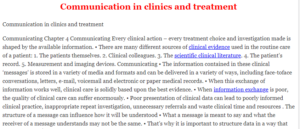Communication in clinics and treatment
Communication in clinics and treatment
Communication in clinics and treatment
Communicating Chapter 4 Communicating Every clinical action – every treatment choice and investigation made is shaped by the available information. • There are many different sources of clinical evidence used in the routine care of a patient: 1. The patients themselves. 2. Clinical colleagues. 3. The scientific clinical literature. 4. The patient’s record. 5. Measurement and imaging devices. Communicating • The information contained in these clinical ‘messages’ is stored in a variety of media and formats and can be delivered in a variety of ways, including face-toface conversations, letters, e-mail, voicemail and electronic or paper medical records. • When this exchange of information works well, clinical care is solidly based upon the best evidence. • When information exchange is poor, the quality of clinical care can suffer enormously. • Poor presentation of clinical data can lead to poorly informed clinical practice, inappropriate repeat investigation, unnecessary referrals and waste clinical time and resources . The structure of a message can influence how it will be understood • What a message is meant to say and what the
receiver of a message understands may not be the same. • That’s why it is important to structure data in a way that maximizes the chance that it will be understood as it is to ensure that the data are correct. • Example, in Figure 4.1, identical patient data are presented in four different ways (Elting et al.,1999) page 39. The message that is sent may not be the message that is received • Messages can be misunderstood both because of the limitations of the agents interpreting them and because the very process of communication is itself limited. Communication channels distort messages Many different communication channels are available, from face-toface conversation, digital channels such as the telephone, e-mail and videoconferencing through to non-interactive channels such as the medical record or letters. Individuals do not know the same things • The inferences drawn from data depend on the knowledge base used to make that inference. Because each individual ‘knows’ slightly different things, he or she may draw different inferences from the same data. • Variations in diagnosis and treatment decisions, based upon the same data, may simply reflect differences in clinical knowledge among individual clinicians. • The knowledge shared among individuals is sometimes called their common ground (Coiera, 2000). This explains why we communicate more easily with others who have similar experiences, beliefs and knowledge The receiver’s knowledge alters the effectiveness of a message Agents vary in the terminology they are familiar with, and communication is often difficult because one agent uses technical terms or jargon with which the other is unfamiliar. When communicating to patients, the decision to avoid jargon is essential. • Example, UK study page 42. A channel is selected based upon its suitability to the task • Interruptive channels: Are called synchronous channels because they demand real-time interaction. • Non-interruptive channels: Are called asynchronous channels because the interaction between agents can occur at separate moments over an extended period. Research has also shown that different types of messages are more effective when transmitted with some channels than with others. Messages are constructed and received according to imperfect models of the world • Sending and receiving messages are model-based processes. • Consequently, the process of communication is fundamentally limited not just by the physical limitations of transmission channels, but also by the inherent limitations of modelling. Messages are constructed and received according to imperfect models of the world Human communication also suffers from limitations in the way humans use models to interpret physical symbols received by our senses: • Perceptual limitations. • Cognitive biases. • Human attentional limitations. Perceptual limitations: Humans may misperceive the symbols that they see or hear. Example: Drug names can be confused because of illegible handwriting. Page 43. Cognitive biases: The distortions introduced by our cognitive architecture do not stop at sense data, but they extend to the interpretation we draw from them. • Perception is an active process in which we try to map what arrives as sense data to our internal models of the world (Van Leeuwin, 1998). • Example, if you think there is an intruder in your house, then you will interpret any sounds you hear from that perspective. Page 44 Human attentional limitations: • Human attention is a cognitive resource with a very limited capacity to process items. • Therefore, when individuals are distracted by other tasks, they are less likely to have the capacity to attend to a new message fully. Grice’s conversational maxims provide a set of rules for conducting message exchanges • How is it that agents, whether they are human or computer, manage to communicate effectively given the many limitations of message exchange? More importantly, given that poor communication can have a profound negative impact on healthcare delivery, what makes a good message? • H. Paul Grice, took a pragmatic approach to the mechanics of conversation. • Grice suggested that well-behaved agents should all try to communicate according to a basic set of rules to ensure that conversations are effective, and that each agent understands what is going on in the conversation (Grice, 1975). Grice’s co-operative principle • Grice’s co-operative principle asks that each agent participating in a conversation should do their best to make it succeed. • Grice proposed a set of four maxims, which explicitly defined what he meant by this principle of co-operation: Grice four maxims: • Maxim of quantity: Say only what is needed. ➢Be sufficiently informative for the current purposes of the exchange. ➢Do not be more informative than is required. • Maxim of quality: Make your contribution one that is true. ➢Do not say what you believe to be false. ➢Do not say that for which you lack adequate evidence. Grice four maxims: • Maxim of relevance: Say only what is pertinent to the context of the conversation at the moment. • Maxim of manner: ➢Avoid obscurity of expression. ➢Avoid ambiguity. ➢Be brief. ➢Be orderly Dose interruptions which disrupt cognitive task can lead to mistakes and harms to patients? • An interruption can be defined as any disruption to a primary task caused by the arrival of an unexpected message. • A life critical situation may demand that clinicians be interrupted to attend to the emerging situation. • In contrast, interrupting someone who is preparing an intravenous medication or calculating a drug dose can lead to a medication administration error and harm to a patient. • Example in page 46. Dose interruptions which disrupt cognitive task can lead to mistakes and harms to patients? • For this reason, managing interruptions has become a significant patient safety issue. • Not all interruptions are harmful, and there are settings in which interruptions appear well tolerated. • Interruptions pose a risk when an interrupted primary task occupies significant attentional and memory resources. • If an interruption occurs during a sequence of sub-tasks, then its position in sequence is important. • Interruptions earlier in sequence are less risky than those toward the end because recovery is more difficult. • Box 4.2 Informatics skill set – interruption management page 47. Structuring Chapter 5 Introduction • Consequently, in health communication Grice’s maxims are not a social nicety, but a professional necessity. When constructing a message, it is therefore insufficient simply to pass on information. • How does one decide what should be put into a clinical conversation, message or document? What is ‘sufficiently informative’ and not obscure or ambiguous? • Using the model of communication developed in Chapter 4, we now set out a process for determining the structure and content of such messages. • Two clinical communication tasks – the handover of patient care and the creation of medical records – Messages are structured for a specific task to suit the needs of the sender and receiver • A message carries a package of data and some of the models needed to interpret the data. A message is therefore typically created to accomplish a specific purpose. • For example, a request for a radiological investigation. Page 51 Messages are structured for a specific task to suit the needs of the sender and receiver • Data-oriented messages contain only data. • Task-oriented messages contain data structured according to specific task models. • Template-oriented messages contain both data as well as separate task models cross-linked to the data. • Page 52 for examples. Messages are structured for a specific task to suit the needs of the sender and receiver • Messages should be structured to emphasize key elements to enable rapid and accurate understanding. • A message template is a standardized method used to structure a message when many different people will receive it. Clinical handover requires messages that successfully transfer responsibility for care • A handover or a handoff is a transfer of responsibility and accountability for the care of a patient from one clinician to another on a temporary or a permanent basis. Clinical handover requires messages that successfully transfer responsibility for care • Handoffs occur at different transitions of care, including: 1. Inter-institution – When a patient is transported from one facility to another, including the transition of care between hospitals, and outpatient and inpatient settings. 2. Inter-departmental – When a patient moves between two departments within the same facility (e.g. from an intensive care unit [ICU] to a ward). 3. 3. Inter-shift – The transfer of care across shifts, including night and weekend care. 4. 4. Inter-professional – The transfer of care between individuals or teams (e.g. between specialties such as medicine and surgery). 5. 5. Intra-team – The transfer of care between members of the same team. Clinical handover requires messages that successfully transfer responsibility for care • Effective handoff is clearly critical to ensuring care continuity and patient safety. • The consequences of handoff failure often harm the patient. • The root cause of much handoff failure is a failure to follow the edicts behind Grice’s maxims. Clinical handover requires messages that successfully transfer responsibility for care The reasons for such failure are often found in the complex and stressed nature of clinical work: ➢Diversity of teams. ➢Ambiguity of roles and processes. ➢Time and resource constraints The patient record can have many different structures • The integrated record presents data chronologically and is data oriented. b. • The source-oriented record is organized according to the source that generated the data and thus is also data oriented. c. • The protocol-driven patient record is pre-structured and dictates what data are to be recorded, as well as the treatment plan, and it is task oriented. d. • The problem-oriented record organizes data accord to a patient’s problems and has four components – a problem list, an initial plan, a database containing all the patient’s data and progress notes. It aims to be template oriented. Page 57 for examples. No single patient record structure will suit every purpose • It is often claimed that the POMR is the ‘best’ patient record structure. • No single patient record structure will suit every purpose, and computer-based patient records have the inherent flexibility to vary their message structure to suit the needs of different clinical tasks. Information management systems Chapter 9 Information management systems • Information is care. • Every clinical decision is predicated on information about the patient and about the patient’s treatment choices. • In this chapter we will discuss firstly, the central notion of an information management cycle is introduced. Second, we explore why it is not always necessary or indeed appropriate to formalize this cycle completely Information systems are designed to manage activities • The main reason that a clinical information system is built is to manage healthcare activities such as the delivery of therapy or administrative tasks such as deciding staffing levels for a hospital unit. • An information model is created to describe the process, including the data elements needed to measure its possible states, and the way that decisions are to then be made based upon those data. Information systems are designed to manage activities • For example, consider the case in which a patient is being treated for an acid–base disorder. • The goal of management is to maintain the patient’s acid–base status in a range consistent with good health. • Measurements such as pH and serum bicarbonate provide the data about acid–base state. • The model used in this case is physiological. It could include rules that describe the relationships between the measured acid–base parameters in health and in disease. Based upon this model of acid–base disease, one can then interpret the measurement data of a given patient • Associated with each interpretation, there usually exists a set of management actions that can be taken. In this example, the actions are a set of therapeutic interventions. Information systems are designed to manage activities The process of activity management generally consists of the following steps: • Define a set of management goals. • Construct a model of the system that incorporates these goals, as well as which measurements are needed to track performance in achieving goals. • Measure the system state by gathering those data specified in the model. • Assess the state of the process being managed by interpreting the measurements using the model. • If needed, manage the process by taking action to alter its state, and move the process to the target state described in the management goals. Information systems are designed to manage activities • This process is usually iterative. Example 118 • Depending on the task, the loop can cycle through many times. • This control loop is the model-measure-manage cycle, and it is at the heart of nearly every information system. • Definition: It is the way in which computer-based information systems are used from the delivery of clinical care to the administration of services and organizations to clinical research. • The plan-do-study-act methodology of system control and organizational management (also known as the Shewhart cycle) There are three distinct information management loops • It is useful to distinguish three distinct model-measure-manage cycles. • These are responsible for the application, selection and refinement of knowledge. • Together, they come together to form the three-loop model which describes the main ways that information is used within an organization, or indeed any system requiring informed control (Figure 9.2) Loop 1 defines the direct application of a model to a task • The first loop is simply the model-measure-manage cycle. Using knowledge contained in a model, measurements are made, and actions are taken. • For example, a clinician may choose an insulin dosing regimen for a diabetic patient. Loop 2 defines the way models are selected and customized • Loop 2 describes the process of deciding which of these models are most appropriate for a specific task. • For example, a clinician must decide which insulin regimen or set of rules is the most appropriate for a given patient. Loop 3 is responsible for model creation and refinement based upon the results of application over time • All knowledge is constantly re-examined, and our understanding of the world evolves with time. • In loop 3, the knowledge used to complete a task is examined against the outcome of application. Formal and informal information systems • Just because it is possible to define an information system, it does not follow that it is always reasonable to go and build it. If that were the case, our lives would be regulated in minute detail. • What happens in reality is that most organizations, small or large, try to find a balance between creating formal processes and allowing individuals to behave freely and informally. • Although structuring processes have clear advantages, including improved reliability, efficiency and consistency, this approach comes with a cost. Formal and informal information systems There are several such costs that need to be considered before a system is formalized: ➢First, the creation of a process, by definition and intent, limits flexibility of response. ➢Second, formalizing the information elements that describe a process usually requires considerable effort. Thus, although a hospital has many formally defined procedures for managing different activities, most activities are left informal. Formal and informal information systems In general, we can make a distinction between information systems in which data are explicitly modelled and those in which data are intentionally left unmodelled: ➢A formal Information system contains an agreed model for the interpretation of data, and data within the system are structured in accordance with that model. ➢An informal information system is neutral to the interpretation of data, containing no model and imposing minimal structure on any data to allow it to be stored, retrieved and shared. Communication systems frequently support informal exchanges • Many processes are a blend of formal information and informal communication elements. • Clinical handover is an example of a communication process that benefits from some structure. • Structured approaches such as SBAR (situation, background, assessment recommendation) page 124 • Communication systems are frequently used to support informal exchanges. • Information flow through an organization occurs both by formal processes and through the informal channels of the organization’s communication infrastructure. When to use Informal information systems • When data are of temporary value, of interest to very few people or are complex. • When the content is not predictable in advance. • When tasks are infrequent, it is more cost-effective to use an informal solution. However, if a task requires formalization because of its frequency or importance, more expensive and specific tools can be brought in to support it.
Purchase answer to see full attachment
Use the following coupon code :
NursesHomework


